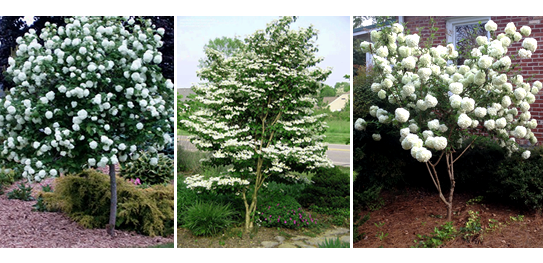Viburnums do not require pruning, however, plants can be pruned for shaping purposes, to remove damaged or dead branches, and many taller growers can be pruned to form a very attractive single- or multi-trunk small tree.
Pruning Instructions
When to Prune
More extensive pruning to reduce size or to tree form should be performed in late winter or very early spring, before new growth begins to emerge. Light pruning for shaping can be performed almost any time of year. To avoid stimulation of new tender growth that could be damaged by a frost and compromise the health of the plant, cease pruning 2 months prior to the average first frost date in your area.
How to Prune
Use a sharp pair of bypass hand pruners when pruning Viburnum. When pruning branches larger than 1" it may be necessary to use long-handle lopper pruners.
How you prune a Viburnum will depend on the variety:
Snowball Viburnum (V. macrocephalum)
This shrub or small tree flowers on old wood, so do not prune until after it flowers. Then prune it as necessary to thin out old branches, open up the shrub, reduce height or develop a better shape. To remove a branch or stem, make cuts a quarter inch from the point where they intersect another branch or the trunk. Avoid cutting too close to the point of origin, which can remove some of the bark and cause injury. Remove dead or diseased wood by pruning the entire branch back to a point of healthy, disease-free growth. You can rejuvenate old plants by cutting them down to a short stump but, after doing so, the shrub may not bloom for two years.
Find tips for tree-forming Snowball Viburnum below.
Other Viburnums
Healthy specimens rarely need pruning. Prune viburnums after flowering only if pruning is necessary for shaping. Old or crowded plants may be thinned and shortened to bring flowers to eye level. After 4 to 5 years you may remove 1/3 of the oldest stems, and thereafter prune every 2 or 3 years.
Tree-Form a Viburnum
Taller growing viburnums can be pruned to form very attractive single- or multi-trunk small trees.

Tree-Forming Young Plants
If you have a young multi-stem viburnum under 2 feet in height, in later winter, when your plant is dormant, choose 1 to 3 of the healthiest and most upright trunks or main branches and remove the rest by cutting them off 1/4" above the ground or from their origin on a trunk. More than 3 trunks is okay. Then allow your viburnum to grow to 4 feet tall or more before removing lower branches to form your tree.
Tree-Forming Older Plants
If your viburnum is 4 feet or taller, in late winter, when your plant is still dormant, begin tree-forming by selecting 1 to 3 of the healthiest and most upright trunks or main branches. If you're lucky, there will be only 1 to 3. More than 3 trunks is okay. Remove unwanted trunks or main branches by cutting them off 1/4" above the ground or from their origin on a trunk. Make sure before you remove a trunk or branch that it will not ruin the look of the canopy (top of the tree). Then start removing the lowest branches and side shoots on the trunks moving your way up and leaving lateral branches on the top 2 feet of growth on a 4- to 5-foot tall shrub.
In future years, as your tree grows taller, you can clip off lower branches, side shoots, or suckers that grow from the base of the trunk(s) until your tree has the desired size and proportion of canopy to trunk. Removal of larger branches should be done during late winter, before new growth has emerged.

